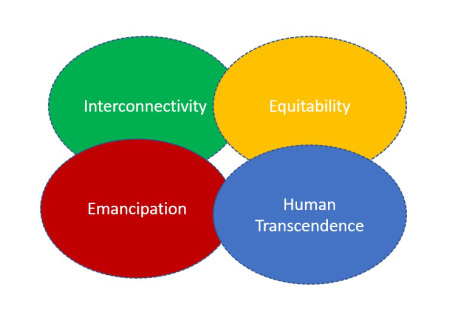The four life principles of the Synchronicity in the Human-Space-Time Theory of Nursing Engagement (SHSTTNE) are interconnectivity, equitability, emancipation and human transcendence. They guide the nurses in translating the theoretical assumptions and caring elements of the SHSTTNE into practice.

Interconnectivity is a principle of human interconnectedness of energy. Energy is continuously moving from “subatomic particles to the biosphere, including the planet Earth, all forming a whole” (Patterson, 1998, p. 289). Interconnectivity leads to the understanding of holism that the bio-psycho-social-spiritual dimensions of persons are interrelated (Lai & Hsieh, 2003) and that the whole being is more than the sum of its organs or systems. The nurse does not focus only on biological curing but considers the healing aspect of the whole person’s being. The nurse becomes more cognizant of the whole integrated person interacting with and influenced by both internal and external environments (Lai & Hsieh, 2003). Applying the principle of interconnectivity through Interpersonal Relating (IR), Technological Knowing (TK), Rhythmical Connecting (RC) & Transformational Engaging (TE), the nurse embraces meaningful connectedness with their patients as whole persons, with the coexistence of human caring and technologies, with the synchronicity among modernist and postmodernist nursing care approaches, and with transformations across nursing engagements.
Equitability is a principle of justice and fairness in human caring across healthcare systems. It revolves around the value-based concept of equity implying fairness in access to health care related to the situated context despite differences in methods, utilization, and outcomes (Cloninger et al., 2014). It can also mean fairness in access to services within an organization. An understanding of the interconnections among space, time, movement and consciousness as health manifestations (Pharris, 2015) leads to meaningful relationships within the HST and beyond. When there are meaningful relationships of persons (i.e., among patients, family, and healthcare team), the nurse is enabled to express equity in nursing care through prioritization, triage, and cost-effective measures in the processes of nursing engagement. In applying equitability, the nurse is cognizant of the difference between equality and equity.
Emancipation is a principle of liberating the self and others from the limits of human-space-time realities. The human-space-time realities of health care could include human factors or attributes such as fear, shame, lack of communication skills, lack of knowledge, powerlessness and human resources. Space factors could mean internal and external environmental limitations. Internal environmental limitations are physiologic, psychologic, emotional and spiritual conditions while the external environment limitations refer to the socio-economic-political challenges as well as the organizational dynamics that influence the nurse and the nursed. The time limit is indicated by the constraints it has on every person such as how long it takes for the nurse to spend for every patient before his/her shift ends, or on the part of the patient how long it takes for him/her to stay in the hospital bed. As described by Chin and Kramer (2011), emancipatory knowing is applied in praxis and in the integration of knowing, doing and being (Parker & Smith, 2015). In the application of the NEP, to emancipate is to know what the nurse can know, doing what one can do, and be with the patient in the present given the limitations of the HST. Both principles of equitability and emancipation are essential in the application of the NEP when “unveiling the dynamics that sustain inequity creates (the) freedom to see and act in a way that improves the health for all” (Parker & Smith, 2015, p.30).
“When people transcend their own egos, dedicate their energy to something greater than the individual self, and learn to build order against the trend of disorder” (Pharris, 2015, p. 285), then the principle of human transcendence is applied. Human transcendence indicates personal growth of persons and professional growth among nurses. Pharris (2015) described the characteristics of growth as “assertion of self, to emancipation of self, to transcendence of self” (p. 292). Through human transcendence, nurses and the nursed can rise beyond their present difficulties. Just as self-transcendence is revealed in the expansion of self-boundaries that enhances well-being (Reed, 2015), human transcendence is also evident in the ability to go beyond the limits of the HST through nursing engagement that fosters human health and well-being. Resilience, for example, is meaningfully connected with well-being through human transcendence.
The four life principles of interconnectivity, equitability, emancipation, and human transcendence are threaded through all the processes in the NEP. As an iterative, nonlinear process of nursing engagement, IR, TK, RC, and TE can co-exist and overlap. Amidst technological advancement in health care, the five caring elements of the dance of caring persons, caring moment, responsive sensing, expression of caring intentions and technological competency (Lim-Saco, Kilat, & Locsin, in press) are emphasized in the application of human caring through the NEP and across healthcare systems worldwide.
References:
Chinn, P., & Kramer, M. (2011). Integrated theory and knowledge development in nursing (8th ed.). St. Louirs, MO: Mosby.
Cloninger, C. R., Salvador-Carulla, L., Kirmayer, L. J., Schwartz, M. A., Appleyard, J., Goodwin, N., … Rawaf, S. (2014). A Time for Action on Health Inequities: Foundations of the 2014 Geneva Declaration on Person- and People-centered Integrated Health Care for All. International Journal of Person Centered Medicine, 4(2), 69–89. https://doi.org/10.1007/s00210-015-1172-8.The
Lai, H., & Hsieh, M. (2003). Alternative Nursing Interventions for Facilitating Holistic Nursing based on Eastern Philosophy. Tzu Chi Nursing Journal, 2(1), 13–19.
Lim-Saco, F., Kilat, C. M., & Locsin, R. (in press). Synchronicity in Human-Space-Time: A Theory of Nursing Engagement in a Global Community. International Journal for Human Caring.
Parker, M.E. & Smith, M.C. (2015). Choosing, Evaluating, and Implementing Nursing Theories for Practice. In M. C. Smith & M. E. Parker (Eds.), Nursing Theories and Nursing Practice 4th Ed. (4th ed., pp. 23–34). Philadelphia, PA: F.A. Davis Company. Retrieved from http://elib.fk.uwks.ac.id/asset/archieve/e-book/KEPERAWATAN/Nursing Theories and Nursing Practice.pdf
Patterson, E. F. (1998). The philosophy and physics of holistic health care: spiritual healing as a workable interpretation. Journal of Advanced Nursing, 27(2), 287–93. https://doi.org/10.1046/j.1365-2648.1998.00533.x
Pharris, M.D. (2015). Margaret Newman’s Theory of Health as Expanding Consciousness. In M. C. Smith & M. E. Parker (Eds.), Nursing Theories and Nursing Practice 4th Ed. (4th ed., pp. 279–300). Philadelphia, PA: F.A. Davis Company. Retrieved from http://elib.fk.uwks.ac.id/asset/archieve/e-book/KEPERAWATAN/Nursing Theories and Nursing Practice.pdf
Reed, P.G. (2015). Pamela Reed’s Theory of Self-Transcendence. In M. C. Smith & M. E. Parker (Eds.), Nursing Theories and Nursing Practice 4th Ed. (4th ed., pp. 411-–419). Philadelphia, PA: F.A. Davis Company. Retrieved from http://elib.fk.uwks.ac.id/asset/archieve/e-book/KEPERAWATAN/Nursing Theories and Nursing Practice.pdf
Copyright © 2018 Freslyn Lim-Saco
Advertisements Share this:




